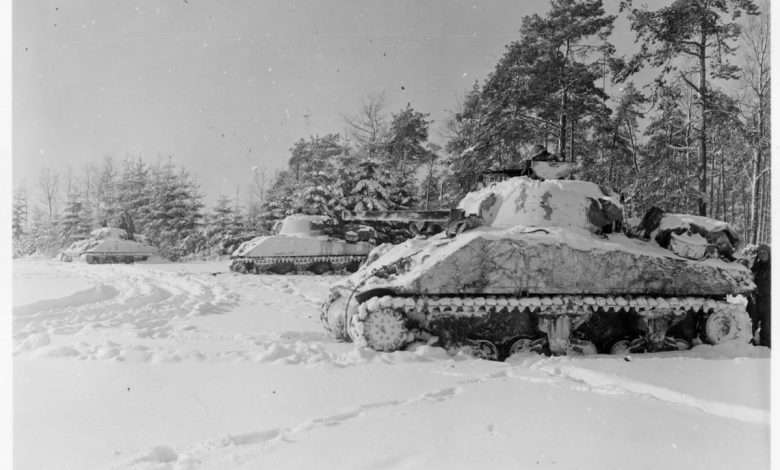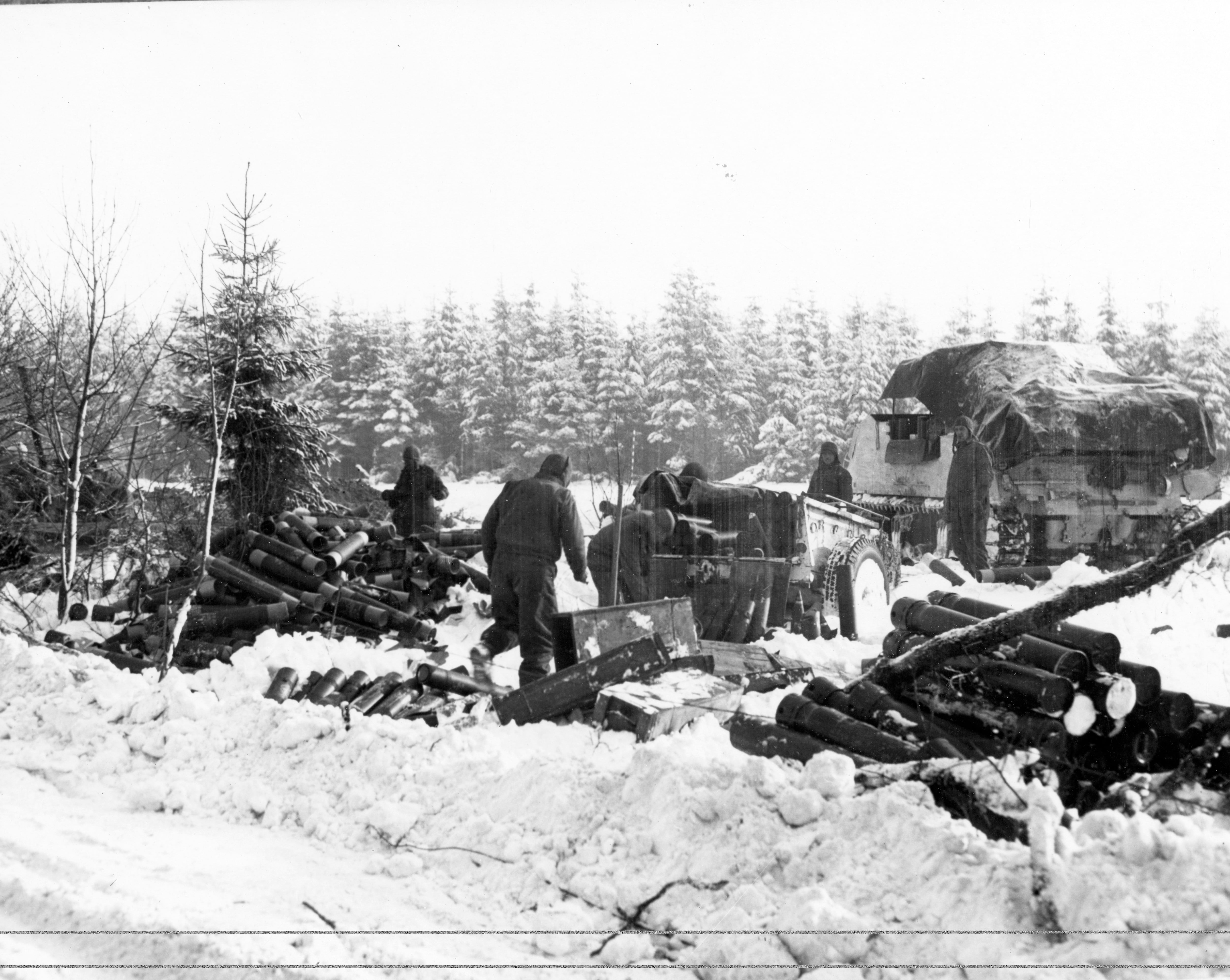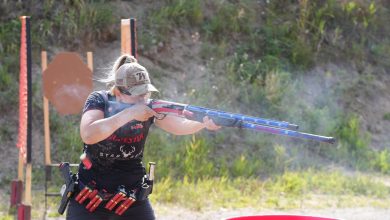At the Battle of the Bulge, this tank commander wouldn’t back down

Brig. Gen. Bruce C. Clarke should have been on leave in Paris, enjoying a well-earned break from the nearly constant combat he’d been in since the D-Day breakout in late July launched the Allied sweep across France led by the tank unit he then commanded — Combat Command A (CCA), 4th Armored Division. When that Allied “Blitzkrieg in Reverse” brought the European war’s front line to Germany’s doorstep that autumn, however, Clarke had been promoted to Brig. Gen. and given command of CCB, 7th Armored Division—a troubled outfit Clarke had quickly whipped into shape.
But, instead of relaxing in Paris, at 2:30 p.m., Dec. 17, 1944, Clarke was on the top floor room of a school in St. Vith, Belgium, a town controlling a vitally important crossroads in the northern sector of the Ardennes Forest region of France, Belgium and Luxembourg. Standing alongside Maj. Gen. Alan W. Jones, the beleaguered and overwhelmed commander of U.S. 106th Infantry Division defending this sector of the Allied front line, the men used binoculars to observe swarms of German infantrymen backed by panzers approaching the town’s eastern outskirts.
A dire situation
Jones’ dire assessment of “losing his division” was unfortunately on target. When the German offensive began at 5:30 a.m., Dec. 16, 1944, the 16,000 infantrymen of his untested 106th Division had held their assigned 22-mile-wide front-line sector — including the Schnee Eifel high ground east of St. Vith which included part of the German Siegfried Line (West Wall) defenses — for only four days.
RELATED
Soon, two of Jones’ three infantry regiments (422nd and 423rd) were surrounded and cut off by the rapidly advancing Germans. The cut-off regiments surrendered Dec. 19 in the largest surrender of American troops in the European Theater. Clarke’s situation when he took command of St. Vith’s defense looked equally dire. Ordered to the Ardennes early that morning, Clarke’s CCB had traveled 80 miles south over frozen roads, the last few miles pushing their way east through roads clogged with U.S. units fleeing west.
Only a portion of Clarke’s tankers and armored infantrymen had reached St. Vith by late afternoon Dec. 17. If you were Bruce C. Clarke facing that desperate situation, what would you do? Here are your most likely courses of action:
1. Fortress St. Vith
With overwhelming German numbers of troops and tanks pouring off of the Schnee Eifel and threatening to engulf St. Vith as your unit barely trickles into the town, establishing a fortified perimeter which can be strengthened by more of your units as they slowly arrive could turn the town into an island of resistance, thereby blocking the Germans from capturing the crossroads. However, this would mean that your defenders would inevitably be surrounded and cut-off. Unbeknownst to you at the time, this is the exactly the defense the 101st Airborne would adopt at Bastogne, further south.
2. Mobile defense
Divide the entire area around St. Vith into “defensive zones/sectors,” within which you would create teams of tanks-infantry to carry out an active mobile defense, trading space for time, when necessary, but if necessary, giving up terrain and fixed defensive positions in order to prolong your defense of the St. Vith overall area as long as possible.
By controlling the overall area, you would deny the Germans free, unfettered use of the vital crossroads, thereby delaying the enemy offensive’s main attack as long as possible.This is the tactic you successfully used in winning the September 1944 Battle of Arracourt, France, the largest American tank battle of the war prior to the Battle of the Bulge.
3. Withdraw west
With the inevitably impending surrender of the 106th’s two full infantry regiments on the Schnee Eifel, there seems no reasonable chance your much smaller combat command (brigade equivalent) can possibly stop the German main attack and deny them full use of the St. Vith road network.
Moreover, you know that the remainder of 7th Armored Division (CCA and CC Reserve) under your division commander, Brig. Gen. Robert Hasbrouck, is forming on the west bank of the Salm River obstacle. Therefore, the tactically prudent decision is for you to withdraw your CCB west behind the Salm River while you still can, adding your combat command’s strength to Brig. Gen. Hasbrouck’s gathering force for the presumed planned Allied counterattack.

What is your decision, General Clarke?
Even before Allied intelligence soon confirmed it, Clarke’s combat experience convinced him this thrust toward St. Vith was the German main attack — it overlapped and paralleled the Ardennes’ “classic invasion route,” the Losheim Gap. Since the “impenetrability” of the rugged Ardennes region was primarily due to its primitive road network, whoever controlled the roads and crossroads controlled the Ardennes. Therefore, holding — or, more importantly, controlling the area surrounding — the few but vital road networks would delay, likely fatally, any rapid German advance through the Ardennes.
Moreover, Clarke’s stunning September 1944 victory at Arracourt in which his brilliant mobile defense of that area by his outnumbered combat command defeated two panzer brigades and major elements of two panzer divisions (Clarke lost 55 tanks/tank destroyers; Germans lost over 200 panzers/assault guns) gave him a virtual “blueprint for victory” at this similar combat scenario at St. Vith. Clarke wisely chose Option 2, Mobile Defense.
Outcome
From Dec. 17 through Dec. 23, Clarke’s CCB, 7th Armored Division conducted a brilliant mobile defense of St. Vith and the surrounding area, delaying Gen. Hasso von Manteuffel’s Fifth Panzer Army for a critical week during the Battle of the Bulge. Although Clarke relinquished the town of St. Vith on Dec. 21, his unit controlled the overall area until Dec. 23 when it was ordered to withdraw behind the Salm River. Historian Russell Weigley judged that “more than any other of the many defensive stands in the Ardennes … it was the battle of St. Vith that bought the time required by Allied generalship to recapture control of the [Bulge] battle.”
Although the heroic Siege of Bastogne (Dec. 20-26, 1944) is the most remembered of the Battle of the Bulge engagements, the 101st paratroopers successfully defended the besieged town against the Germans’ supporting attack; Clarke’s defense of St. Vith blunted and fatally delayed the enemy main attack. Later, Clarke summed up what it took to persevere and win at St. Vith: “The job of a commander in a battle when attacked by an overwhelming force is to prevent the confusion from becoming disorganized, and to eliminate command and staff inertia so that the reaction to crises can be swift and effective.”
This story originally appeared on HistoryNet.com.
Read the full article here






